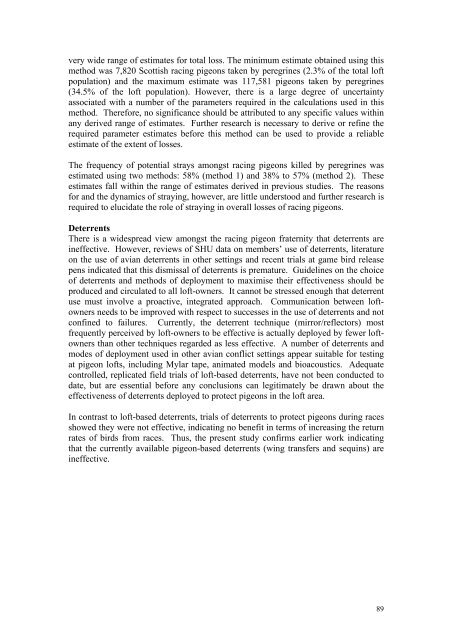RACING PIGEONS â IMPACT OF RAPTOR PREDATION
RACING PIGEONS â IMPACT OF RAPTOR PREDATION
RACING PIGEONS â IMPACT OF RAPTOR PREDATION
You also want an ePaper? Increase the reach of your titles
YUMPU automatically turns print PDFs into web optimized ePapers that Google loves.
very wide range of estimates for total loss. The minimum estimate obtained using this<br />
method was 7,820 Scottish racing pigeons taken by peregrines (2.3% of the total loft<br />
population) and the maximum estimate was 117,581 pigeons taken by peregrines<br />
(34.5% of the loft population). However, there is a large degree of uncertainty<br />
associated with a number of the parameters required in the calculations used in this<br />
method. Therefore, no significance should be attributed to any specific values within<br />
any derived range of estimates. Further research is necessary to derive or refine the<br />
required parameter estimates before this method can be used to provide a reliable<br />
estimate of the extent of losses.<br />
The frequency of potential strays amongst racing pigeons killed by peregrines was<br />
estimated using two methods: 58% (method 1) and 38% to 57% (method 2). These<br />
estimates fall within the range of estimates derived in previous studies. The reasons<br />
for and the dynamics of straying, however, are little understood and further research is<br />
required to elucidate the role of straying in overall losses of racing pigeons.<br />
Deterrents<br />
There is a widespread view amongst the racing pigeon fraternity that deterrents are<br />
ineffective. However, reviews of SHU data on members’ use of deterrents, literature<br />
on the use of avian deterrents in other settings and recent trials at game bird release<br />
pens indicated that this dismissal of deterrents is premature. Guidelines on the choice<br />
of deterrents and methods of deployment to maximise their effectiveness should be<br />
produced and circulated to all loft-owners. It cannot be stressed enough that deterrent<br />
use must involve a proactive, integrated approach. Communication between loftowners<br />
needs to be improved with respect to successes in the use of deterrents and not<br />
confined to failures. Currently, the deterrent technique (mirror/reflectors) most<br />
frequently perceived by loft-owners to be effective is actually deployed by fewer loftowners<br />
than other techniques regarded as less effective. A number of deterrents and<br />
modes of deployment used in other avian conflict settings appear suitable for testing<br />
at pigeon lofts, including Mylar tape, animated models and bioacoustics. Adequate<br />
controlled, replicated field trials of loft-based deterrents, have not been conducted to<br />
date, but are essential before any conclusions can legitimately be drawn about the<br />
effectiveness of deterrents deployed to protect pigeons in the loft area.<br />
In contrast to loft-based deterrents, trials of deterrents to protect pigeons during races<br />
showed they were not effective, indicating no benefit in terms of increasing the return<br />
rates of birds from races. Thus, the present study confirms earlier work indicating<br />
that the currently available pigeon-based deterrents (wing transfers and sequins) are<br />
ineffective.<br />
89
















